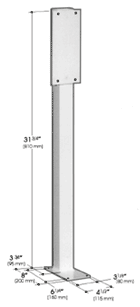
Access solutions for most any need. |
 |
|

Access solutions for most any need. |
 |
|
There should be handrails to both sides of ramps or steps. Some people, such as those who have had strokes, may have a disability on one side of the body and therefore need a handrail on one side for going up and on the other side for coming down. The handrails are best as a 45 to 50mm diameter mop handle types which are easier to grip. Metal can be cold to grip. Regulations and recommendations suggest a range of heights. For ease of use by people of different stature, heights between 850 and 1000mm above step nosing or ramp services are good. Balustrades to protect from falling over edges may need to be higher than these, in which case a separate handrail should be provided below the guarding rail. Handrails should be continuous up the steps or ramp and should project beyond the top and bottom by 300mm. Tactile markings on the handrails before the ends will give forewarning to people with visual impairments (or to anyone who is not concentrating). Handrails should be clearly visible by color and tonal contrast. The ADA emphasizes grab bar installation because handicapped persons use them to maintain balance, transfer, and prevent falls. They are the number one answer to a barrier free design, and are specified, by the ADA, in both new and existing buildings |